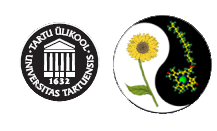Fine-tuning of the antenna spectra
The ways photosynthetic organisms - plants, algae, and bacteria - harvest solar energy and adjust flexibly to environmental extremes has been of considerable long time interest. At least partly, this steady attention is uelled by the hope of finding useful biomimetic principles applicable in synthetic molecular devices. Closely packed non-covalently bound pigment molecules constitute the photoactive part of most photosynthetic complexes, while the protein frame affects the electronic properties of the pigments by supplying them individual binding sites. The latter interactions are the source of the so-called solvent shift, whilst the couplings between the neighboring pigments that lead to delocalisation of the excitation over a number of molecular units are broadly classified as excitonic. Earlier investigations have frequently demonstrated a capacity of the solvent shift and excitonic interactions in modification of spectral properties of the antenna complexes. However, quantitative characterization of these mechanisms, when simultaneously present in the same antenna structure, has never been achieved. The purple photosynthetic bacterium Rhodopseudomonas acidophila is unique in that it develops two types of circular transmembrane antennas named LH2 and LH3, which appear structurally highly homologous, but spectrally remarkably distinct. We have taken advantage that the polarized fluorescence excitation spectroscopy is able to expose the exciton bands of the circular antennas, even if strong inhomogeneous broadening hides them. By using this technique, the observed large (~680 cm-1) blue shift of the LH3 absorption band relative to that in LH2 was uniquely separated into the individual pigments solvent shift (82%) and the collective exciton shift terms (18%). Other factors, such as electron-phonon coupling and inhomogeneous broadening that primarily influence the exciton dynamics, have also been considered as potential contributors to the spectral fine-tuning. (Spectrally selective spectroscopy of biomolecules & biomolecular complexes).
